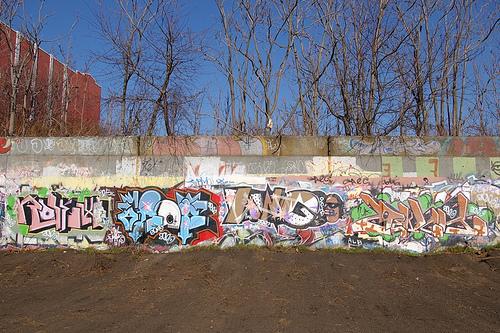Various people have been thinking about a graffiti museum for a while. Graffiti is now in galleries and museum collections, and has been for some time. The graff and street art show at LA’s Museum of Contemporary Art back in 2011 set attendance records. But there’s no permanent museum for graffiti, despite the fact that graffiti’s up on walls around the world. Not one. And a good thing too. Because a graffiti museum would be beside the point.

Let’s review. The institutional structure of the art world as we know it was set in place by the 19th Century. First, of course, is the artist, often lionized as a tortured genius, or at least as a randy imp. The collector and patron, both individual and institutional (all those public monuments). They pay for the whole show. And then we have galleries and museums.
That’s it. For the last 30 or even 40 years people have been trying to shove graffiti (and street art) into those boxes. And it doesn’t fit.

Meanwhile, photography gets invented in the 19th Century. It helped put the screws to realistic painting, but, truth be told, realism had its own issues generated from within. In the 20th Century color photography had become good enough so that, in conjunction with color printing, high quality reproductions became plentiful and relatively cheap. One could also make nice museum catalogues and nicely illustrated books on the history of art.
But all this photographic activity is either outside of or merely plastered on the outside of the basic institutional circuit: artist, collector, gallery, and museum. Photographs could document what the artist did but it played no essential role in the creative process and it wasn’t until well into the 20th century that photography became recognized as an art unto itself. As for all those decent to high-quality reproductions, they just expanded the reach of the basic circuit, but didn’t change the internal dynamics.

That began to change with graffiti. Or rather, graffiti arose outside that institutional circuit–artist, collector, gallery, and museum, and it’s never really settled into it, despite valiant attempts at force fitting. The original writers, the guys – mostly guys but not entirely (e.g. Lady Pink) – did think of themselves as artists and didn’t aspire to a position in the traditional institutional quadrille. They put their names on walls and subway cars. They were writers.
It’s only when people began photographing their work and showing the photos around that the question arose: Is it Art? At the same time photographs became a way of preserving work that was going to disappear sooner or later. If the authorities didn’t “buff” the wall, other writers would go over it or, in time, the weather would degrade it. So, you paint your burner in the yard at night then you go out the next morning and flic it as it rolls along the bend. Now you’ve got a more or less permanent record of what you did.
You had the thrill of painting it and you have that photograph. Some people will see the original in situ, if only your friends and rivals, the important people. What more could you want? Let the authorities buff it away.

And so it goes.
This process has only accelerated and expanded in the age of the digital camera, smart phone, the web, and Instagram. Write it, flic it, upload it, and the world can see it. The important point, then, is that photography is integral to this process. Whatever the graffiti circuit is, photography is on the inside, not the outside. In this circuit, what’s the point of a museum? What purpose would it serve? Permanence? Writers got over that long ago. The experience itself is not and cannot be permanent. And photography provides a record of what’s been done. What more do we need? Something, perhaps. Something. But a museum’s not going to provide it.
Let’s invent.

See: Photographing Graffiti; The Camera in the Gallery, the World as Collage; The World-Wide Wall; and various posts about graffiti sites, this one, for example.

